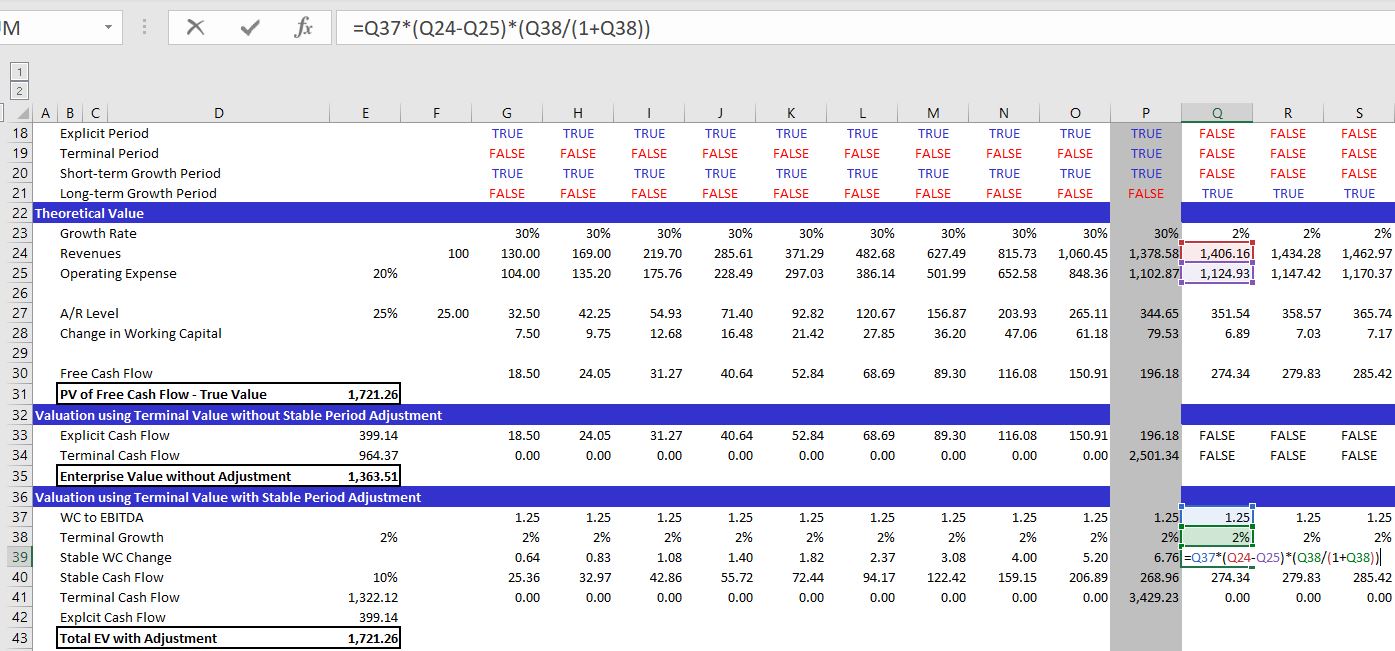

Finance
How Does Working Capital Work
Published: December 19, 2023
Learn how working capital works in finance. Discover the importance and benefits of managing your company's cash flow efficiently.
(Many of the links in this article redirect to a specific reviewed product. Your purchase of these products through affiliate links helps to generate commission for LiveWell, at no extra cost. Learn more)
Table of Contents
Introduction
Working capital is a fundamental concept in finance that plays a crucial role in the financial health and success of businesses. It is a key metric that measures a company’s operational liquidity and ability to cover short-term obligations. Understanding how working capital works is essential for business owners, investors, and financial professionals.
Simply put, working capital refers to the difference between a company’s current assets and current liabilities. It represents the amount of capital available for day-to-day operations, such as paying suppliers, employees, and other short-term expenses. It is an indicator of a company’s short-term financial health and efficiency in managing its resources.
In this article, we will explore the definition of working capital, its components, how to calculate it, its importance in financial management, and strategies to effectively manage and improve working capital.
By gaining a solid understanding of working capital and its implications, businesses can ensure proper cash flow management and long-term financial stability. Investors can assess a company’s liquidity position and make informed decisions. Financial professionals can implement effective working capital management strategies to optimize resources and drive profitability.
Definition of Working Capital
Working capital refers to the amount of money or resources a company has available to cover day-to-day operational expenses and obligations. It is a measure of a company’s short-term liquidity and financial health. Working capital is a vital aspect of financial management, as it ensures that a business can meet its short-term obligations and effectively operate.
The calculation of working capital is derived by subtracting the current liabilities from the current assets. Current assets include cash, accounts receivable, inventory, and other assets that can be converted into cash within a year. Current liabilities include accounts payable, short-term debt, and other obligations that are due within a year.
Having sufficient working capital is essential for a company to finance its operations, pay its suppliers, and maintain a healthy cash flow. It provides the necessary buffer to cover unexpected expenses, take advantage of growth opportunities, and survive economic downturns.
Insufficient working capital can lead to issues such as cash flow problems, missed payments to suppliers, and an inability to fulfill customer orders. On the other hand, an excess of working capital may indicate inefficient use of resources and missed investment opportunities.
It is important to note that working capital requirements vary depending on the industry, business cycle, and individual company circumstances. Therefore, it is crucial for businesses to assess their specific needs and establish an appropriate working capital level to ensure smooth operations and financial stability.
Overall, working capital is a key metric that provides insights into a company’s short-term financial health, liquidity position, and ability to meet its current obligations. By managing working capital effectively, companies can optimize cash flow, maintain a healthy financial position, and support their long-term growth and success.
Components of Working Capital
The components of working capital are the elements that make up the difference between a company’s current assets and current liabilities. These components provide insights into a company’s operational liquidity and its ability to manage short-term financial obligations. Understanding the components of working capital is crucial for assessing a company’s financial health and implementing effective financial management strategies.
The two main components of working capital are current assets and current liabilities.
Current Assets:
Current assets are resources that a company expects to convert into cash or use up within a year. They are typically more liquid and can be easily utilized to meet short-term financial obligations. Here are some common examples of current assets:
- Cash: The most liquid asset that a company holds, including cash on hand and cash in bank accounts.
- Accounts receivable: Amounts owed to the company by its customers for goods or services provided on credit.
- Inventory: The value of products or materials that a company holds for sale or use in its operations.
- Short-term investments: Investments that can be easily converted into cash without incurring significant losses.
- Prepaid expenses: Payments made in advance for goods or services that are yet to be received.
Current Liabilities:
Current liabilities are obligations that a company is expected to settle within a year. These represent the amounts the company owes to its creditors and vendors. Here are some examples of current liabilities:
- Accounts payable: Amounts owed by the company to its suppliers for goods or services received on credit.
- Short-term debt: Debt that is due within a year, such as lines of credit, short-term loans, and current portions of long-term debt.
- Accrued expenses: Expenses that have been incurred but not yet paid, such as salaries, utilities, and taxes.
- Unearned revenue: Payments received in advance for goods or services that are yet to be provided.
The difference between current assets and current liabilities represents working capital. A positive working capital indicates that the company has enough resources to cover its short-term obligations. Conversely, a negative working capital suggests a potential liquidity issue and may require immediate attention.
By closely monitoring and managing the components of working capital, businesses can maintain a healthy cash flow, meet their financial obligations, and ensure smooth operations.
Current Assets
Current assets are a crucial component of working capital and represent the resources that a company expects to convert into cash or use up within a year. These assets provide liquidity and support the day-to-day operations of a business. Understanding the different types of current assets and their management is essential for effective working capital management.
Cash:
Cash is the most liquid asset in a company’s portfolio. It includes the physical currency on hand, as well as cash in bank accounts. Cash is essential for covering immediate expenses, such as paying salaries, purchasing inventory, and settling short-term liabilities. Effective cash management is vital to ensure that there is enough liquidity to meet operational requirements.
Accounts Receivable:
Accounts receivable represents the amounts owed to a company by its customers for goods or services provided on credit. It is an asset that arises from sales made on credit terms and is recorded as a current asset on the balance sheet. Managing accounts receivable involves setting credit terms, monitoring payment collections, and taking necessary actions to minimize bad debts. Efficient accounts receivable management improves cash flow and reduces the risk of non-payment.
Inventory:
Inventory consists of raw materials, work-in-progress, and finished goods that a company holds for sale or use in its operations. Maintaining an appropriate level of inventory is crucial to meet customer demand while avoiding excess inventory costs. Effective inventory management involves minimizing stockouts, optimizing order quantities, and regularly assessing inventory turnover to ensure the efficient use of resources.
Short-term Investments:
Short-term investments are financial instruments that can be easily converted into cash within a year. These investments provide businesses with an opportunity to earn returns on excess cash while maintaining liquidity. Common examples of short-term investments include treasury bills, money market funds, and short-term bonds. Careful consideration should be given to the risk and liquidity factors when selecting short-term investment options.
Prepaid Expenses:
Prepaid expenses represent payments made in advance for goods or services that are yet to be received. These expenses are recorded as current assets and are gradually recognized as expenses over time. Common examples of prepaid expenses include prepaid insurance premiums, prepaid rent, and prepaid maintenance costs. Monitoring prepaid expenses helps companies in accurately tracking their future liabilities and managing their cash flow.
Managing current assets effectively is crucial for maintaining a healthy level of working capital. Companies need to strike a balance between having enough liquidity to meet short-term obligations and maximizing the productive use of their assets. By actively managing current assets, businesses can optimize their working capital and support their ongoing operations and growth.
Current Liabilities
Current liabilities are an important component of working capital and represent the obligations that a company is expected to settle within a year. These liabilities reflect the short-term financial obligations that need to be managed effectively to ensure the smooth functioning of a business. Understanding the different types of current liabilities and their management is essential for maintaining a healthy working capital position.
Accounts Payable:
Accounts payable represent the amounts owed by a company to its suppliers for goods or services received on credit. It is a common current liability that arises from purchasing goods or services on credit terms. Managing accounts payable involves careful monitoring of payment terms and maintaining positive relationships with vendors. Timely and accurate payments can help businesses foster good vendor relationships and avoid late payment penalties.
Short-Term Debt:
Short-term debt includes any debt that is due within a year. This may include lines of credit, short-term loans, and the current portion of long-term debt. Businesses often use short-term debt to finance working capital needs or cover unexpected expenses. Careful management of short-term debt is crucial to ensure that the company can meet its financial obligations and avoid any potential cash flow constraints.
Accrued Expenses:
Accrued expenses are expenses that have been incurred but not yet paid. These expenses typically include items such as salaries, utilities, rent, and taxes. Accrued expenses are recorded as liabilities because the company has an obligation to pay them in the future. Proper tracking and management of accrued expenses are important to avoid any disruption in the company’s operations and ensure the timely payment of obligations.
Unearned Revenue:
Unearned revenue represents payments received in advance for goods or services that are yet to be provided. It is a liability because the company has not yet fulfilled its obligations to the customer. As the company delivers the goods or services, the unearned revenue gets recognized as revenue on the income statement. Managing unearned revenue involves proper tracking and ensuring the timely delivery of goods or services to fulfill the company’s obligations to its customers.
Managing current liabilities is crucial for maintaining a healthy working capital position. It involves careful monitoring of payment terms, managing cash flow to meet obligations, and optimizing the timing of payments to maintain positive vendor relationships. By effectively managing current liabilities, businesses can ensure a smooth cash flow, minimize financial risks, and maintain a strong financial position.
Calculating Working Capital
Calculating working capital is a straightforward process that involves subtracting a company’s current liabilities from its current assets. The resulting figure represents the working capital available to the company for its day-to-day operations. This calculation provides a snapshot of a company’s short-term liquidity and its ability to meet its financial obligations.
The formula to calculate working capital is:
Working Capital = Current Assets – Current Liabilities
Let’s break down the components of the formula:
Current Assets:
Current assets include cash, accounts receivable, inventory, short-term investments, and prepaid expenses. To calculate working capital, add up the value of all these current assets.
Current Liabilities:
Current liabilities include accounts payable, short-term debt, accrued expenses, and unearned revenue. Add up the value of these current liabilities.
Once you have the total value of current assets and the total value of current liabilities, subtract the total value of current liabilities from the total value of current assets. The resulting figure is the working capital.
It is important to note that the working capital number can be positive or negative:
- If the working capital is positive, it means that the company has more current assets than current liabilities. This indicates that the company has sufficient liquidity to cover its short-term obligations and fund its day-to-day operations.
- If the working capital is negative, it means that the company has more current liabilities than current assets. This suggests that the company may face liquidity challenges and may struggle to meet its short-term obligations.
Calculating working capital is a crucial step in assessing a company’s financial health and liquidity position. It provides valuable insights into the short-term financial strength of a business and helps stakeholders make informed decisions regarding investments, financing, and overall financial management strategies.
Importance of Working Capital
Working capital is a vital metric for businesses of all sizes and across industries. It serves as a measure of a company’s short-term financial health and its ability to manage day-to-day operations effectively. The importance of working capital lies in its impact on various aspects of a business, including cash flow, operational efficiency, and overall financial stability.
Cash Flow Management:
Working capital ensures that a company has sufficient liquidity to cover its short-term obligations and maintain a healthy cash flow. It allows businesses to pay suppliers on time, meet payroll expenses, and manage day-to-day operational expenses. Proper cash flow management is crucial for sustaining operations, investing in growth opportunities, and weathering financial challenges.
Operational Efficiency:
Having adequate working capital enables businesses to operate smoothly. It ensures the availability of resources, such as inventory and raw materials, to meet customer demand promptly. Insufficient working capital can lead to stockouts, delayed production, and missed sales opportunities. On the other hand, excess working capital may indicate inefficient use of resources. Maintaining an optimal level of working capital is key to maximizing operational efficiency.
Financial Stability:
Working capital is an indicator of a company’s financial stability. A positive working capital signifies that the company has enough resources to cover its short-term liabilities, making it less reliant on external financing. It provides a cushion for unexpected expenses, economic downturns, and other financial challenges. Sufficient working capital helps businesses maintain their obligations and sustain operations even during difficult times.
Growth and Expansion:
Working capital plays a crucial role in supporting growth and expansion initiatives. It provides the necessary funds to invest in research and development, marketing, and acquiring new assets. Adequate working capital allows businesses to capitalize on growth opportunities and expand their operations without compromising their financial stability.
Access to Financing:
Having a healthy level of working capital can enhance a company’s creditworthiness and increase its ability to access financing options. Lenders and investors often assess working capital as part of their evaluation process. Adequate working capital demonstrates a company’s ability to meet its financial obligations, reducing the risk for lenders and investors.
Overall, working capital is a critical aspect of financial management. It impacts a company’s cash flow, operational efficiency, financial stability, growth prospects, and access to financing. By effectively managing working capital, businesses can improve their financial position, mitigate risks, and set a solid foundation for long-term success.
Managing Working Capital
Managing working capital is a key aspect of financial management that involves controlling and optimizing the company’s current assets and liabilities to ensure efficient cash flow and maximize profitability. Effective working capital management helps businesses maintain liquidity, meet short-term obligations, and pursue growth opportunities. Here are some strategies for managing working capital effectively:
1. Cash Flow Forecasting:
Developing accurate cash flow forecasts allows businesses to anticipate and plan for their cash needs. By monitoring cash inflows and outflows, businesses can identify potential cash shortages or surpluses and take proactive measures to manage their working capital accordingly.
2. Streamline Accounts Receivable:
Efficient management of accounts receivable is crucial for maintaining a healthy cash flow. Implementing clear credit terms and credit policies, sending timely and accurate invoices, and actively following up on overdue payments can help minimize outstanding receivables and improve cash collection.
3. Optimize Inventory Levels:
Striking the right balance between maintaining sufficient inventory to meet customer demand and avoiding excess stock is essential. Implementing inventory management techniques such as just-in-time (JIT) inventory, accurate demand forecasting, and regular inventory monitoring can help reduce holding costs and improve cash flow.
4. Negotiate Favorable Payment Terms:
Negotiating favorable payment terms with suppliers can enhance cash flow and working capital management. Extending payment terms or taking advantage of early payment discounts can help businesses hold on to cash for longer or reduce the overall cost of goods and services.
5. Control Operating Expenses:
Monitoring and controlling operating expenses can contribute to efficient working capital management. Regularly reviewing expenses, identifying cost-saving opportunities, and implementing cost-cutting strategies can free up cash and improve the overall financial health of the business.
6. Evaluate Working Capital Policies:
Reviewing and reassessing working capital policies and procedures on a regular basis is essential. This includes analyzing credit terms, payment policies, inventory management strategies, and other aspects of working capital management. By identifying areas for improvement, businesses can optimize their working capital management practices.
7. Utilize Technology:
Implementing technology solutions such as automated accounting systems, inventory management software, and cash flow forecasting tools can streamline processes and improve accuracy in managing working capital. Technology can enhance visibility, provide real-time data, and enable better decision-making in working capital management.
Effective working capital management requires a holistic approach that balances the need for liquidity with the utilization of resources. By implementing these strategies, businesses can maintain a healthy working capital position, optimize cash flow, and position themselves for sustainable growth and success.
Strategies to Improve Working Capital Management
Improving working capital management is crucial for businesses to enhance their financial health, optimize cash flow, and maximize profitability. By implementing effective strategies, companies can better manage their current assets and liabilities, leading to improved liquidity and operational efficiency. Here are some strategies to improve working capital management:
1. Tighten Accounts Receivable Processes:
Implementing stricter credit policies, conducting thorough credit checks on customers, and promptly following up on overdue invoices can help accelerate cash inflows. Offering incentives for early payment and utilizing technology solutions for efficient invoicing and collection processes can also help improve accounts receivable management.
2. Optimize Inventory Management:
Reducing excess inventory levels, implementing just-in-time (JIT) inventory methods, and utilizing accurate demand forecasting techniques can help businesses minimize holding costs and improve cash flow. Regularly analyzing inventory turnover ratios and identifying slow-moving or obsolete stock can free up funds for other working capital needs.
3. Negotiate Favorable Payment Terms with Suppliers:
Working closely with suppliers to negotiate longer payment terms or taking advantage of supplier discounts for early payments can improve cash flow and working capital management. Building strong supplier relationships and exploring opportunities for vendor financing or consignment arrangements can also provide financial flexibility.
4. Enhance Cash Flow Forecasting:
Developing robust cash flow forecasting processes allows businesses to anticipate cash needs and proactively manage working capital. Accurate cash flow forecasting enables companies to identify potential shortfalls or surpluses, take appropriate actions to address them, and make informed decisions about financing and investment opportunities.
5. Streamline Accounts Payable Processes:
Efficient accounts payable management involves implementing streamlined processes for invoice verification, approval, and payment. Leveraging technology solutions for invoice processing and automation can help reduce processing time, minimize errors, and optimize cash outflow.
6. Improve Working Capital Policies:
Regularly reviewing and updating working capital policies can help businesses optimize their management practices. This includes setting clear guidelines for credit terms, payment policies, inventory controls, and other aspects of working capital. Establishing benchmarks and key performance indicators (KPIs) to track and evaluate working capital performance can aid in identifying areas for improvement.
7. Consider Working Capital Financing Options:
In times of temporary cash flow constraints, businesses may consider working capital financing options such as short-term loans, lines of credit, or factoring. These financing options can provide prompt access to funds, bridge temporary cash gaps, and support operational needs.
By implementing these strategies, businesses can actively manage their working capital and improve cash flow efficiency. Balancing the management of current assets and liabilities is essential for maintaining a healthy financial position, meeting short-term obligations, and laying the foundation for long-term growth and success.
Working Capital and Cash Flow
Working capital and cash flow are interrelated aspects of financial management that play a crucial role in the day-to-day operations and overall financial health of a business. While working capital focuses on the difference between current assets and liabilities, cash flow tracks the inflow and outflow of cash within a specified period. Understanding the relationship between working capital and cash flow is essential for effective financial management.
Working Capital and Cash Flow:
Working capital and cash flow are closely interconnected. Working capital represents the funds available to a company for its daily operations, including payment of short-term obligations. It serves as a cushion to cover incoming and outgoing cash flows. Positive working capital indicates that a company has enough resources to meet its short-term liabilities, while negative working capital suggests it may struggle to satisfy its obligations.
Cash flow, on the other hand, tracks the movement of cash into and out of a business. It measures the actual inflow and outflow of cash over a specific period, such as a month or a quarter. Cash flow is influenced by various factors, including sales revenue, operating expenses, accounts receivable collection, accounts payable payments, and investment and financing activities.
The Relationship:
Working capital and cash flow are interconnected in the following ways:
– Positive working capital generally leads to positive cash flow. Sufficient working capital ensures that a company has the necessary funds to cover its short-term obligations when they become due, resulting in a healthy cash flow.
– Inadequate working capital can strain cash flow. If a company lacks sufficient working capital to cover its liabilities, it may experience cash flow difficulties, such as delayed payments to suppliers or missed opportunities due to insufficient funds.
– Cash flow can affect working capital requirements. A positive cash flow may allow a company to invest in additional working capital to support business growth or expansion. Conversely, negative cash flow may force a company to reduce its working capital, potentially impacting its operations and financial stability.
Managing Working Capital and Cash Flow:
Effective management of working capital and cash flow is crucial for business sustainability. Here are some strategies to consider:
– Monitor and maintain an optimal level of working capital by regularly assessing cash flow projections and adjusting current assets and liabilities accordingly.
– Implement cash flow management techniques such as accurate forecasting, timely invoicing and collections, and efficient payment processes to optimize cash flow.
– Utilize working capital financing options, such as lines of credit or short-term loans, to bridge temporary cash flow gaps and support operational needs.
– Continuously review and improve working capital and cash flow management policies and procedures to ensure they align with business objectives and industry standards.
By effectively managing working capital and maintaining a healthy cash flow, businesses enhance their financial stability, improve operational efficiency, and position themselves for long-term success.
Working Capital Ratio
The working capital ratio is a financial metric that measures the relationship between a company’s current assets and its current liabilities. It provides insights into a company’s ability to meet its short-term obligations and the level of liquidity it holds. The working capital ratio is also referred to as the current ratio or working capital position.
Calculating the Working Capital Ratio:
The formula to calculate the working capital ratio is:
Working Capital Ratio = Current Assets ÷ Current Liabilities
The working capital ratio is obtained by dividing a company’s current assets by its current liabilities. Current assets are resources that can be easily converted into cash within a year, such as cash, accounts receivable, and inventory. Current liabilities are obligations that are due within a year, including accounts payable, short-term debt, and accrued expenses.
Interpreting the Working Capital Ratio:
The working capital ratio is expressed as a numerical value, with the ideal ratio varying among industries. Generally, a ratio above 1 indicates that a company has more current assets than current liabilities, suggesting it has sufficient liquidity to pay off its short-term obligations. A ratio below 1 suggests that a company may face difficulties meeting its current liabilities.
While a high working capital ratio may indicate a healthy liquidity position, a very high ratio may suggest that the company is holding excess assets that could be deployed elsewhere. On the other hand, a low working capital ratio may signal potential liquidity issues or an inefficient allocation of resources.
Using the Working Capital Ratio for Analysis:
The working capital ratio serves as a useful tool for financial analysis and comparison. Here are some key considerations when using the working capital ratio:
– Industry Comparison: Comparing a company’s working capital ratio to industry peers can provide insights into how well it is managing its current assets and liabilities relative to similar businesses.
– Historical Analysis: Analyzing the trend of a company’s working capital ratio over time can indicate whether its liquidity position is improving or deteriorating. Significant changes in the ratio may warrant further investigation into the company’s financial health.
– Benchmarking: Setting internal benchmarks for the working capital ratio can assist in assessing the company’s performance against its own goals and targets.
– Risk Assessment: A low working capital ratio may signal financial risk, such as a potential inability to meet short-term obligations. It may be necessary to take appropriate measures, such as improving collections or managing inventory more efficiently, to mitigate these risks.
Limitations of the Working Capital Ratio:
While the working capital ratio provides valuable insights, it has some limitations. It does not consider the composition or quality of current assets or the timing of cash inflows and outflows. Additionally, it does not account for factors such as future sales or long-term investments.
Overall, the working capital ratio is a helpful tool to evaluate a company’s short-term liquidity position. By monitoring and analyzing this ratio, businesses can gain insights into their financial health, make informed decisions, and implement strategies to optimize their working capital management.
Conclusion
Working capital is a vital aspect of financial management that plays a significant role in a company’s short-term liquidity, financial health, and operational efficiency. It represents the funds available for day-to-day operations, covering expenses, and meeting short-term obligations. Understanding and effectively managing working capital is crucial for businesses of all sizes and industries.
In this article, we explored the definition of working capital, its components, the calculation method, and its importance. We delved into strategies for managing working capital effectively, including optimizing cash flow, streamlining accounts receivable and payable processes, and assessing working capital policies. We also discussed the relationship between working capital and cash flow, highlighting the significance of maintaining a healthy cash flow to support the working capital needs of a business.
By actively managing working capital, businesses can enhance their financial stability, improve cash flow, and position themselves for long-term growth and success. Efficient working capital management allows companies to meet short-term obligations, optimize resource utilization, and make informed decisions about investments, financing, and operational strategies.
It is important to note that the optimal working capital level may vary among industries and individual companies. Factors such as industry dynamics, business cycles, and strategic goals influence the working capital requirements. Therefore, businesses should conduct regular assessments, monitor key performance indicators, and adjust their working capital management strategies accordingly.
In conclusion, working capital is a fundamental element of financial management that requires attention and proactive management. By maintaining an optimal working capital position, businesses can ensure sufficient liquidity, improve cash flow, and foster a stable and resilient financial foundation for long-term success.














